Auspicious Design on China Silk
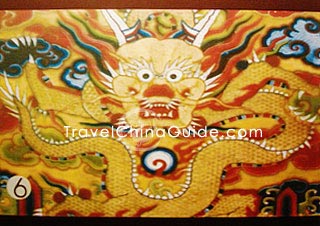 The auspicious design on China silk originated in Shang Dynasty (16th-11th century BC), developed in Tang (618-907) and Song (960-1279) dynasties and reached its greatest in Ming (1368 - 1644) and Qing (1644 - 1911) dynasties. The auspicious design has become the symbol of China national spirit and important part of traditional Chinese culture.
The auspicious design on China silk originated in Shang Dynasty (16th-11th century BC), developed in Tang (618-907) and Song (960-1279) dynasties and reached its greatest in Ming (1368 - 1644) and Qing (1644 - 1911) dynasties. The auspicious design has become the symbol of China national spirit and important part of traditional Chinese culture.In Ming and Qing dynasties, every design is endowed with auspicious meanings. What the designs wants to express can be summed up in four meanings, "Fu, Gui, Shou and Xi". "Fu" means rich or good harvest. "Gui" symbolizes power and prestige. "Shou" is related to longevity and safety. "Xi" refers to marriage, the blessings of children and friendship. The auspicious designs on the silks in Ming and Qing dynasties have a vast range of themes: birds and beasts; flowers, grass, trees and stones; bees, bugs and fish. The deep meanings are expressed by three composition ways. The first and most commonly used one is by decorative design, the second is by euphony and the third one is by written description.
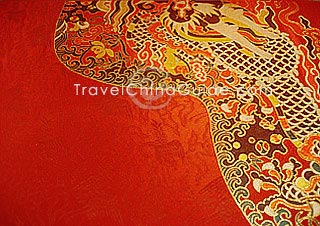 The expression of meaning by decorative design is to extend the sense of natural properties of animals and plants, such as the use of Chinese dragon, phoenix and boa to stand power and honor. The dragon is always regarded as the totem of Chinese nation, thus the dragon patterns are widely used in arts and crafts. In Ming and Qing Dynasties, the patterns of the golden dragon with five claws were the exclusive use of royal families. The cypress tree, due to its immortal greenness, is often used in a blessing of longevity. The Silktree Albizzia leaves extend in the morning and fold in the evening, which symbolizes the harmony between couples. The many seeded fruits such as pomegranate and grapes are a wish of more sons and more blessings. Peach and crane imply a long life.
The expression of meaning by decorative design is to extend the sense of natural properties of animals and plants, such as the use of Chinese dragon, phoenix and boa to stand power and honor. The dragon is always regarded as the totem of Chinese nation, thus the dragon patterns are widely used in arts and crafts. In Ming and Qing Dynasties, the patterns of the golden dragon with five claws were the exclusive use of royal families. The cypress tree, due to its immortal greenness, is often used in a blessing of longevity. The Silktree Albizzia leaves extend in the morning and fold in the evening, which symbolizes the harmony between couples. The many seeded fruits such as pomegranate and grapes are a wish of more sons and more blessings. Peach and crane imply a long life.The expression of meaning by euphony is closely related to Chinese partial tones. The distinct feature of Chinese characters makes the existence of euphony and pun. A speech sound often corresponds to several Chinese characters. For example, in Chinese, the pronunciations of "bottle" and "peaceful" sound the same. The partial tone of the magpie is happiness and the partial tone of longan or sweet osmanthus is honorable.
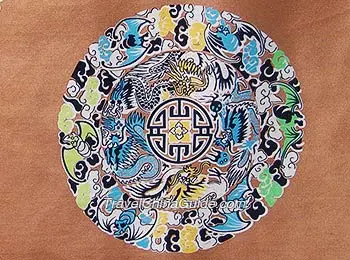 Besides, the auspicious designs can be directly expressed by written description and often with the Chinese characters of good augury such as 'Fu' (fortune), 'Shou' (longevity) and 'Xi' (happiness). This method is found to be widely used in the brocade in Han Dynasty (206BC-220AD). It developed on an unprecedented scale in Ming and Qing dynasties. The character 'Shou' has already become a lucky emblem which has over 300 graphic designs. 卍 was formally a Sanskrit which means the lucky emblem on chest. During the rule of the Emperor Wu Zetian, it was used as a Chinese character, pronounced the same as 'Wan'. But mostly, it is still used as a design. The interlocking 卍 implies extensity and broad.
Besides, the auspicious designs can be directly expressed by written description and often with the Chinese characters of good augury such as 'Fu' (fortune), 'Shou' (longevity) and 'Xi' (happiness). This method is found to be widely used in the brocade in Han Dynasty (206BC-220AD). It developed on an unprecedented scale in Ming and Qing dynasties. The character 'Shou' has already become a lucky emblem which has over 300 graphic designs. 卍 was formally a Sanskrit which means the lucky emblem on chest. During the rule of the Emperor Wu Zetian, it was used as a Chinese character, pronounced the same as 'Wan'. But mostly, it is still used as a design. The interlocking 卍 implies extensity and broad.Surely in actual operating, the three methods are used in combination. For instance, the commonly seen design combinations are "Three More": more blessings, more longevity and more children, which are represented by fingered citron, peach and pomegranate respectively; 'Five bats and longevity": five bats surround the Chinese character 'Shou' (longevity); "Lotus and sons": designed by the combination of lotus flower or lotus pod and boys, as well as some peanuts.
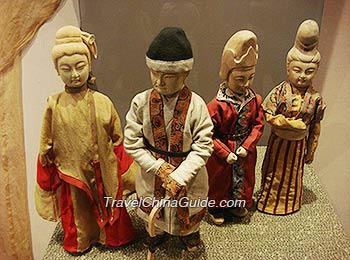 | 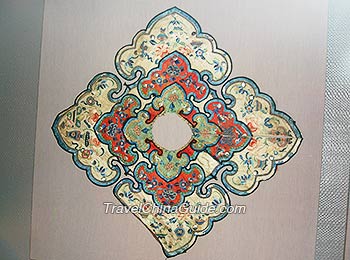 |
- Last updated on Apr. 20, 2021 -